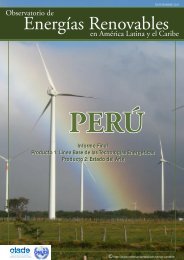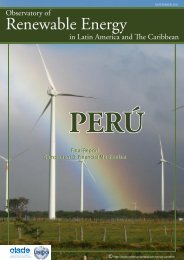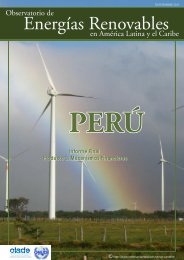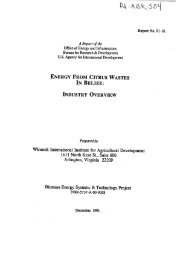PERÃ - Observatory for Renewable Energy in Latin America and
PERÃ - Observatory for Renewable Energy in Latin America and
PERÃ - Observatory for Renewable Energy in Latin America and
Create successful ePaper yourself
Turn your PDF publications into a flip-book with our unique Google optimized e-Paper software.
<br />
Perú- Products I <strong>and</strong> II<br />
<br />
1. BASE LINE OF ENERGY TECHNOLOGIES<br />
1.1 Introduction<br />
Due to the renewable resources perspectives of their greater use (hydroelectric <strong>and</strong><br />
other ones) <strong>and</strong> the improvement of the energy consumption pattern to encourage<br />
the susta<strong>in</strong>able development <strong>in</strong> the country, this report describes the base l<strong>in</strong>e of<br />
the most important technologies <strong>for</strong> the national energy system, the role that te<br />
renewable energies are play<strong>in</strong>g <strong>and</strong> their relevant practices <strong>in</strong> Peru. For it, it is<br />
shown the current general energetic <strong>in</strong><strong>for</strong>mation, its problems, the legal <strong>and</strong><br />
<strong>in</strong>stitutional framework of renewable energies <strong>and</strong> the recent regulatory re<strong>for</strong>ms<br />
devoted to promote its development <strong>and</strong> use through the application of <strong>in</strong>centives<br />
to promote the <strong>in</strong>vestment <strong>in</strong> renewable projects <strong>and</strong> technologies. Furthermore, it<br />
is given <strong>in</strong><strong>for</strong>mation of the most relevant facilities that use renewable <strong>and</strong> non<br />
renewable energy sources. F<strong>in</strong>ally, it is expla<strong>in</strong>ed the teach<strong>in</strong>gs derived from the<br />
base l<strong>in</strong>e analysis of technologies <strong>and</strong> renewable energy facilities, emphasiz<strong>in</strong>g the<br />
determ<strong>in</strong>ation of the factors <strong>for</strong> its practice <strong>and</strong> contribution to the susta<strong>in</strong>able<br />
development of the country.<br />
The Peruvian electrical system has a production structure dom<strong>in</strong>ated by renewable<br />
resources. Be<strong>for</strong>e the Camisea gas entrance, the contribution of hydroelectricity <strong>in</strong><br />
2000 was of 87 % but <strong>in</strong> 2010 this participation fell to 56 %, due to the growth of<br />
the natural gas use <strong>in</strong> electricity generation. As <strong>for</strong> the <strong>in</strong>stalled capacity, <strong>in</strong> 2010<br />
renewable technologies accounted <strong>for</strong> about 48 % of the total, be<strong>in</strong>g the rema<strong>in</strong><strong>in</strong>g<br />
percentage of fossil fuels technologies. (MEM, 2011i).<br />
It is important to emphasize that with the entrance <strong>in</strong>to commercial transaction of<br />
the Camisea project, <strong>in</strong> August of 2004, it started an important change <strong>in</strong> the<br />
consumption pattern of the energy Peruvian system. Nowadays, the gas reserves<br />
exceed the ones of oil <strong>and</strong> its consumption shows a constant growth s<strong>in</strong>ce then,<br />
keep<strong>in</strong>g the preponderance of fossil resources <strong>in</strong> front of the renewable ones <strong>in</strong> the<br />
national energy supply.<br />
The advantages of the presence of natural gas <strong>in</strong> the energy matrix are the<br />
substitution of the oil by-products, reduc<strong>in</strong>g imports <strong>and</strong> improv<strong>in</strong>g the country’s<br />
balance of trade. Besides, its price has benefited the electricity sector keep<strong>in</strong>g the<br />
electricity tariffs down. As a disadvantage we have that their production costs<br />
cont<strong>in</strong>ue be<strong>in</strong>g cheaper than the ones associated with renewable energies, favor<strong>in</strong>g<br />
their implementation.<br />
1.2 Methodology<br />
The <strong>in</strong><strong>for</strong>mation sources <strong>for</strong> the base l<strong>in</strong>e development of energetic technologies<br />
<strong>and</strong> the art state can be grouped as follows:<br />
a) Energetic source of <strong>in</strong><strong>for</strong>mation.<br />
13









